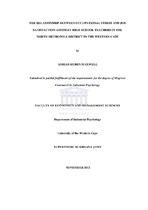| dc.description.abstract | Numerous studies have evaluated occupational stress and job satisfaction of teachers in South Africa (Jackson & Rothmann, 2006; Olivier & Venter, 2003; Steyn & Kamper, 2006; Rothmann & Coetzee, 2006; Schulze & Steyn, 2007; Van Tonder & Williams, 2009). Teachers in the Western Cape, like their counterparts in the rest of the country, face issues of transformation and uncertainty in the environment (Muller, 2008). In addition to stress which arise from the work itself, studies have indicated that lower job satisfaction leads to high staff turnover and less new entries into the profession (Steyn & Kamper, 2006).Stress causes both physiological and psychological damage (McKenna, 2006). Stress can drive individual performance but severe stress lowers coping resources of staff and reduces work performance and overall job satisfaction (Stranks, 2006). Kauer (2011) showed that when teachers are dissatisfied with their work they are more likely to experience occupational stress. Staff who are frustrated in their work or have unsatisfied needs experience increased tension leading to lower work motivation (Robbins & DeCenzo, 2007). If stress levels are known it may be isolated and coping mechanisms may be developed to motivate teachers and create a healthy work environment (Arnold, 2005). It has been found that job stress and the lack of job satisfaction are associated with physical illness amongst teachers (Peltzer, 2009). Strategies to reduce occupational stress, techniques to build resistance to it and methods to alter the appraisal of workplace stressors may serve to enhance the job satisfaction of teachers. It has been found that occupational stress in teaching is of severe proportions (Zurlo, Pes & Cooper, 2007) and that satisfaction in teaching is determined by the extent to which teachers are satisfied with certain job satisfaction determinants within their work environment (Andersen, 2011, Olulube, 2006, Weiqi, 2006, Drukpa, 2010). Monyatsi (2012), Yahaya and Husain (2011), Hanif, Tariq and Nadeem (2011), Klassen and Chiu (2010), Kauts and Saroj (2010) and Ngimbudzi (2009) found that biographical variables such as gender and tenure impact on the levels of job satisfaction reported by teachers.The aim of this study is to investigate the relationship between occupational stress and job satisfaction of teachers in the North Metropole district in the Western Cape, to explore the factors that may contribute to these respective variables and to recommend ways to improve and enhance the delivery of quality education in the Western Cape. A non-probability sampling method in the form of convenience sampling was used to collect the sample. The sample comprised of 118 participants who were from seven schools in a particular geographically defined area within the North Metrolole district of the Western Cape. Primary data was collected by means of a self-developed biographical questionnaire. The Occupational Stress Scale was administered to measure occupational stress and the Job Satisfaction Survey was used to measure job satisfaction in teachers. Both instruments have been proven reliable and valid. The data was analyzed in terms of descriptive statistics (namely the mean, standard deviation, frequencies and percentages) as well as inferential statistics (namely the Pearson Product Moment, and the T-Test). | en_US |

